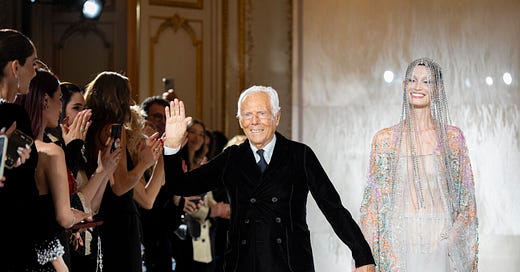Also in this issue:
Dior menswear designer Kim Jones is knighted and ousted in the same week
Film director Bennett Miller’s photography at Galerie Gagosian
Didier Ludot auction results
When I first started covering couture in Paris 30 years ago—as a stringer for Cathy Horyn at The Washington Post—show week was a very staid affair. Socialite clients, retailers and journalists like me filed into the rococo ballrooms of either the Intercontinental Hotel (now Westin) or the Grand Hotel, and watched a slow-paced parade of extremely tasteful clothes for women. At the time, there were all sorts of strict rules from the Chambre Syndicale de la Haute Couture, France’s official couture organizing body, such as:
The brand had to present at least 50 looks, both day and evening wear;
the atelier had to have at least 15 full-time staff and 20 full-time “technical” employees, like as seamstresses, machinists, and tailors;
the atelier had to be in Paris—any brands headquartered outside of Paris, like Versace or Valentino, were “invitees”;
the company had to show during the official couture week twice a year.
Every show, which went on for at least 45 minutes—a look a minute, basically—opened with a section dedicated daywear, such as suits, dresses, and coats; then moved on to cocktail wear; then evening wear; and closed with a wedding dress. Basically, if a young woman had traveled to Paris to shop for her trousseau, she could find everything at one house. (She’d go to Cadolle for lingerie.)
The house’s ready-to-wear collection would then reinterpret many of those couture looks in more affordable fabrics, and have them mass-manufactured in factories. Example: I saw a beautiful black faille cocktail dress in Hubert de Givenchy’s final couture show in July 1995—it was very Audrey Hepburn—then saw the same dress in a cotton weave in his final ready-to-wear collection in October. I bought the ready-to-wear version; my daughter now has it and wears it a lot.
This regimented couture show structure was turned on its head when John Galliano was hired by LVMH, first at Givenchy in 1995, then at Christian Dior in 1996. Galliano wasn’t terribly interested in daywear, or wearable clothes for that matter. He talked about couture as a “laboratory of ideas,” which meant referencing Joan of Arc, with armor-like sleeves, or Britain’s King Henry VIII, with poufy Tudor-esque tunics, or Native Americans, with feathers, beaded fringe, and other costume-y clichés.
Couture’s raison d’être then split in two: To generate publicity through outrageous, outlandish designs, which would likely go to museums; or to generate revenue by selling pretty clothes to wealthy women.
And so it has remained, as I saw last week during the Spring-Summer 2025 couture shows in Paris.
Keep reading with a 7-day free trial
Subscribe to Dana Thomas to keep reading this post and get 7 days of free access to the full post archives.





